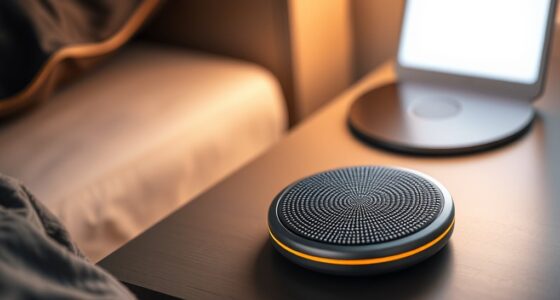Smartphone earthquake warning systems for deaf users rely on visual cues like bright flashes and on-screen messages, as well as tactile alerts such as vibrations, to guarantee timely awareness. These systems incorporate customizable settings, high-contrast designs, and community feedback to improve accessibility. While challenges remain—like signal reliability and device compatibility—innovations are advancing globally. Exploring these solutions further reveals how technology and community efforts are creating more inclusive safety measures for everyone.
Key Takeaways
- Deaf-centered earthquake warning systems utilize visual, tactile, and customizable alerts to ensure timely notifications on smartphones.
- High-contrast visuals, bright flashes, and vibration cues are key features enhancing alert visibility and accessibility.
- Global innovations include community engagement and real-time sensor data to improve alert accuracy and cultural relevance.
- Challenges such as signal reliability, device compatibility, and user trust require ongoing technological and community-focused improvements.
- Future directions emphasize multi-modal alerts, local community involvement, and integration of advanced sensor technology for better inclusivity.
The Architecture of Smartphone Alert Systems for Deaf Users

Because deaf users cannot rely on auditory alerts, smartphone alert systems for them are built with multiple layers of technology. These systems emphasize visual and tactile cues to guarantee timely warnings. For example, visual notifications often appear as bright flash alerts or on-screen messages that catch your attention immediately. Tactile alerts, like vibrations, serve as another critical layer, especially when visual cues might be missed. The architecture also integrates emergency protocols that activate instantly when an earthquake is detected, triggering these cues seamlessly. This multi-layered approach ensures that deaf users receive urgent alerts without depending on auditory cues alone. Incorporating alert customization options allows users to tailor notifications to their preferences, further enhancing safety. By combining visual, tactile, and rapid response mechanisms, the system effectively guarantees your safety during an earthquake.
Accessibility Features and Design Considerations

Designing earthquake warning systems with accessibility in mind requires careful attention to diverse user needs. You should prioritize clear visual design that effectively captures attention without causing confusion. Use high-contrast colors, bold icons, and simple layouts to ensure warnings are noticeable by users with visual impairments or in bright environments. Incorporate user customization options, allowing individuals to choose alert types, sounds, or visual cues that suit their preferences and needs. This flexibility helps make the system more inclusive and effective for everyone. Additionally, consider adjustable settings for vibration intensity or screen brightness to accommodate different sensitivities. Understanding how contrast ratio impacts image quality can inform the design of visual alerts, making them clearer and more distinguishable. By focusing on thoughtful visual design and user customization, you create a more accessible, reliable, and user-friendly earthquake warning experience for all users.
Case Studies From Different Countries and Technologies

Across various countries, innovative earthquake warning systems demonstrate how technology can be tailored to diverse needs and environments. In Japan, community engagement plays a key role, with local residents helping refine alert delivery to ensure accessibility for deaf users. Technological innovations, like ShakeAlert in the U.S., leverage advanced sensors and real-time data analysis to provide early warnings through smartphones and public alert systems. Mexico’s early warning system integrates community input, making alerts more effective and culturally appropriate. In New Zealand, mobile apps use localized data, combining community feedback with innovative algorithms for accurate warnings. These case studies show that combining community engagement with technological innovations enhances earthquake warning systems, ensuring they serve all users effectively across different regions. Understanding accessibility helps improve the inclusiveness of these systems for all users.
Challenges and Limitations in Deaf-Centered Earthquake Warnings

While technological solutions for deaf-centered earthquake warnings have advanced, several challenges still hinder their effectiveness. First, signal reliability remains a concern; inconsistent or weak signals can cause missed alerts. Second, user engagement is essential; if users don’t trust or understand the system, they may ignore alerts. Third, device compatibility limits reach; not all smartphones support specialized alert features. Fourth, language and cultural barriers can reduce comprehension, especially in diverse communities. Additionally, ensuring that alerts are accessible and effective for all users requires ongoing vetted systems and community outreach. These issues highlight that, despite progress, ensuring consistent, clear, and trusted alerts is difficult. Without reliable signals and active user engagement, deaf-centered warnings risk being ineffective. Overcoming these challenges requires ongoing improvements in technology, community outreach, and inclusive design.
Future Directions for Inclusive and Effective Alerts

To create more inclusive and effective earthquake alerts, future efforts must focus on integrating advanced technology with community-centered approaches. Enhancing audience engagement is key, ensuring alerts resonate across diverse groups and accessibility needs. Technological innovation can improve alert delivery, making notifications faster, clearer, and more personalized. Incorporating multi-modal signals—visual, auditory, and haptic—can better serve deaf and hard-of-hearing communities. Additionally, involving local communities in designing and testing alert systems fosters trust and relevance. Continuous feedback loops enable you to refine messaging and technology, ensuring alerts are practical and user-friendly. Emphasizing the importance of proper storage of alert information can help maintain the integrity and timely delivery of warnings during emergencies. By merging cutting-edge innovations with active community participation, you can develop more inclusive systems that save lives and empower everyone to respond effectively during earthquakes.
Frequently Asked Questions
How Do Smartphone Alert Systems Integrate With Existing Emergency Infrastructure Globally?
You should understand how smartphone alert systems integrate with existing disaster communication infrastructure worldwide. These systems often connect via technology integration, enabling rapid alerts during emergencies. They sync with local authorities and emergency services, guaranteeing crucial information reaches people quickly. By leveraging mobile networks and alerts, you can receive timely warnings, which enhances global disaster response efforts and ensures that even vulnerable populations stay informed and safe during crises.
What Training Is Available to Help Deaf Users Understand Earthquake Alerts Effectively?
Did you know that over 5% of the world’s population has some form of hearing loss? To help deaf users understand earthquake alerts, there are sign language tutorials and visual alert training available. These programs teach you how to interpret flashing lights, vibration alerts, and sign language notifications effectively. By participating, you’ll gain confidence in recognizing alerts quickly, ensuring your safety during emergencies.
How Do Cultural Differences Impact the Acceptance of Deaf-Centered Alert Systems?
Cultural perceptions play a significant role in how you accept deaf-centered alert systems, as they shape attitudes toward disability and technology. Communication barriers may cause skepticism or misunderstanding, making it harder for you to trust or adopt these systems. If your culture values inclusivity and accessibility, you’re more likely to embrace deaf-centered alerts. Conversely, cultures with limited awareness or negative perceptions can hinder acceptance, impacting safety and effective communication.
Are There Any Privacy Concerns Associated With Smartphone-Based Earthquake Alert Data?
Oh, the irony isn’t lost—you’re worried about privacy when your phone warns you of earthquakes! Yes, there are concerns about data privacy and user consent, especially since location and health data might be shared. While these alerts save lives, you should stay cautious, ensuring your data isn’t used beyond the alert system. Ultimately, you want safety without sacrificing your privacy, right?
How Can Smartphone Alerts Be Adapted for Users With Multiple Disabilities?
You should focus on creating multimodal alerts that combine visual, auditory, and haptic cues, guaranteeing accessibility customization for diverse disabilities. Incorporate multilingual notifications so users receive alerts in their preferred language. By tailoring these features, you make earthquake warnings more inclusive for users with multiple disabilities, helping them understand and respond quickly. This approach ensures everyone gets timely, clear, and accessible information during emergencies.
Conclusion
As you navigate the world of earthquake alerts, remember that each innovation is a beacon guiding deaf users safely through storms of uncertainty. These systems act as unwavering lighthouses, cutting through darkness and silence, offering hope and security. By embracing inclusive design, you become part of a brighter future—where every signal, like a steady heartbeat, reminds us that safety and understanding shine brightest when shared by all. Together, we build a world where no one is left in the shadows.











